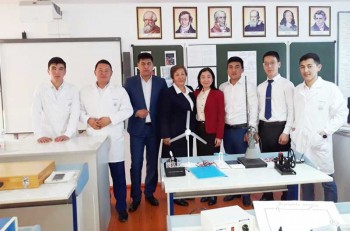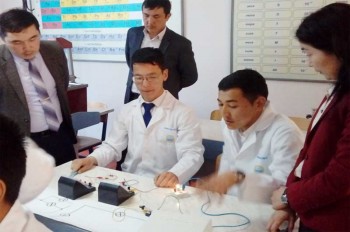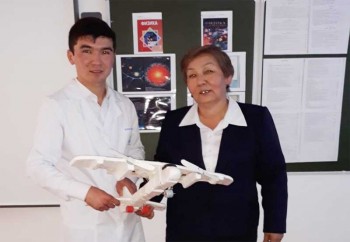The work of the circle in physics
- 120 views
On March 5, teachers of the Department of Higher Mathematics and Physics of the Syrdarіya University, Candidate of Pedagogical Sciences, Associate Professor Tilla Berdaliyeva and others, Senior Lecturer Kanat Ulukbayev held a circle.
The theme of our circle is “Fundamentals of teaching physics”, where students prove physical theory in the form of experiments in their free time.
Tilla Dosybekovna said that today's club will be held in the form of a small seminar. "Fundamentals of Teaching Physics" here is a comparison of the textbook "Physics" for grade 7 with the new textbook of 2003 and the textbook of 2017, according to the new curriculum. The textbooks are called "Physics and Astronomy" in our original textbook and "Physics" in the new textbook. This textbook will be analyzed by 3rd year students of the "Expertise" group in comparison with our original textbook, textbooks of new content, and the "Experiment" group will demonstrate their experience of working in pairs.
Bektenov Gaukhar: "The development of science and technology, additional materials for students." When comparing the history of science and technology with our original textbook, the textbook does not contain any information. In addition to the interesting content of the new content, the symbol is also highlighted in yellow. The additional in-depth material is the same in both of our books. In the new textbook, only the notation has changed. Our original textbook briefly deals with astronomy. In the new textbook, a lot of attention is paid to physics, and the symbol is highlighted in yellow. As for applications, in comparison with the two books in the original book, table 9 is given, and in the new textbook - table 11. Table 2 shows the complex names of the elements of physics.
Experiment
“Light distribution” was demonstrated by students Talip Dinara and Begimbet Aktolkyn. Here he explained how to take pictures of bodies with various optical lenses. Experience has shown that the forms of the body can be enlarged, inverted, reduced and false.
Student Himmatova Perizot presented "Aggregate states of liquid" with the help of practical equipment. They include a stand with 400 ml internal and external thread, device holder, flask, two-hole rubber stopper, thermometer, metal tube, hose, glass beaker, alcohol, base plate and water.
The order of work was as follows:
First, we place a stand with 400 ml of internal and external threads on the base plate.
Place the flask on the stand with the device holder.
Fill the flask (two) with water and place the thermometer in one of the two perforated rubber stoppers and the metal tube in the other.
Place one end of the hose in a metal tube and the other end in a glass beaker and apply alcohol.
We monitor the initial state of the thermometer and hose before and after boiling water.
“The use of wind and solar energy” was demonstrated by students Kuan Berdybek and Rysbek Nurdaulet. In order to use electricity efficiently in the future, we need to generate electricity from the sun and wind. After all, electricity is currently generated by hydroelectric power plants. When a hydroelectric plant runs out of power, we need to generate electricity from the sun and wind. It uses solar panels to generate electricity from the sun and wind turbines to generate electricity from the wind.
Demonstration of experience
It shows that in parallel connection, the current increases, the voltage is constant, and the electrical resistance decreases, and in series connection, the current is constant, the voltage increases, and the electrical resistance increases. He said that he uses a parallel connection in his daily life.



